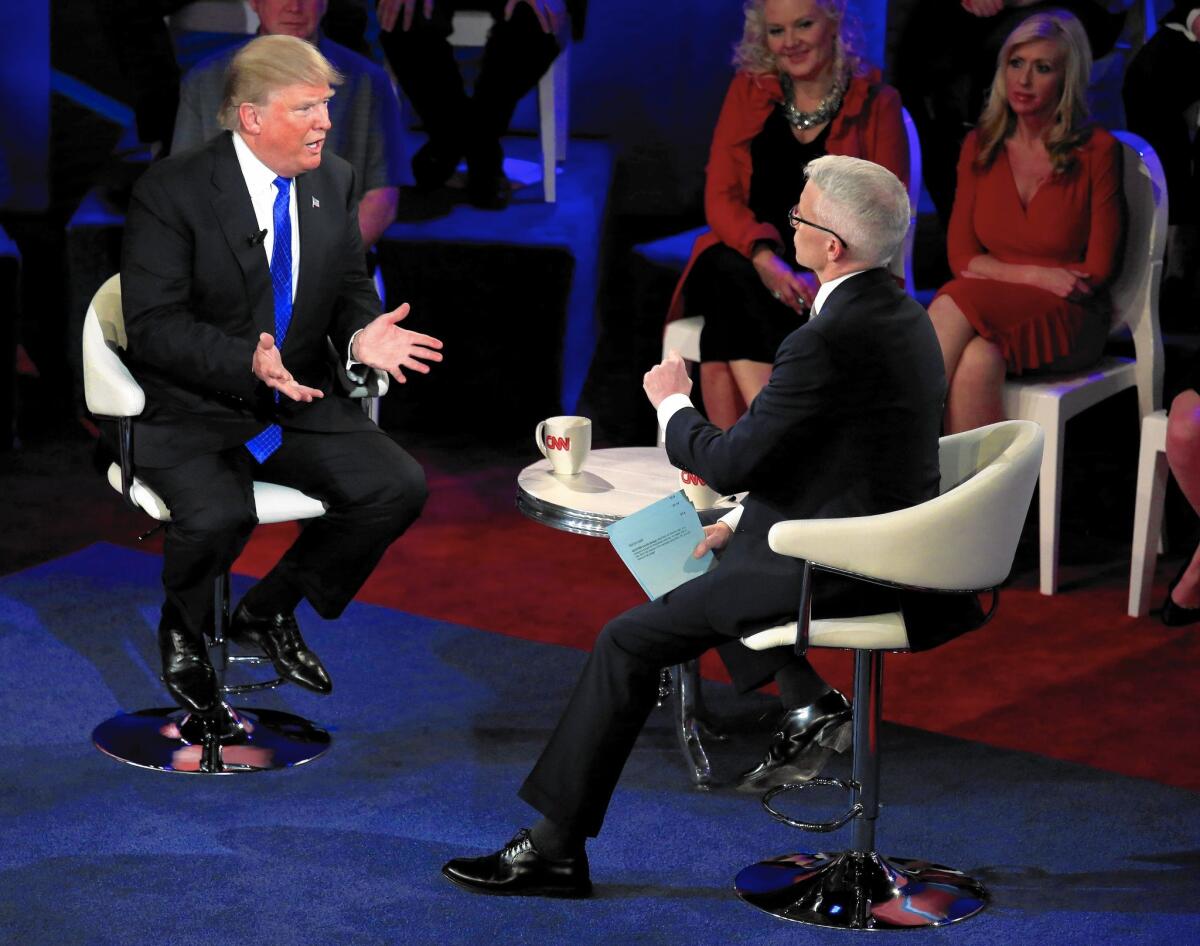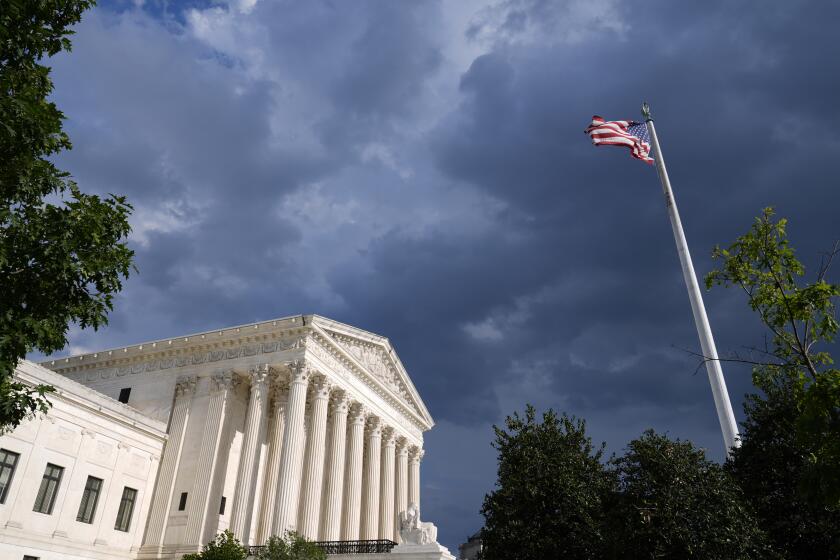Town halls are the new cable news hit of the 2016 campaign

Donald Trump, left, appears with Anderson Cooper in a CNN town hall on Tuesday.
- Share via
Donald Trump turned the Republican presidential debates into high-rated TV spectacles. But the fate of his quest for the nomination may be decided by a far more intimate televised forum.
The “town hall” — in which a candidate typically has a one-on-one exchange with an anchor and takes questions from voters — has become an increasingly popular format on cable news networks. There have already been 24 of them across CNN, Fox News and MSNBC, up from just a handful in the entire 2012 campaign. While town halls don’t deliver the same massive Nielsen numbers as the debates, they are still potent from a ratings standpoint and give TV news a chance to drill deeper into the candidates’ policy positions.
The programs also help mitigate ongoing charges by some critics that TV news is giving the media-friendly Trump too much free airtime and has not subjected him to enough rigorous questioning (a study from MediaQuant said Trump received $189.80 worth of free media coverage for every dollar he’s spent on paid advertising through February).
The Republican front-runner had the rockiest week of an otherwise surprisingly successful campaign largely because of his answer to a question from MSNBC’s Chris Matthews during a Wednesday town hall. Matthews asked if a woman should be punished for having an abortion if the procedure became illegal. Trump said yes, but then revised his position after an outcry from both abortion rights activists and abortion foes. He has been dogged by the statement ever since and his favorable rating with women voters has plummeted.
A debate is like three-dimensional chess or a simple knife fight... The town hall allows you to have a conversation with the candidate.
— Anderson Cooper
“I’ve noticed the town hall moderators are getting tougher, especially on Trump,” said Larry Sabato, professor of politics at the University of Virginia.
“A debate is like three-dimensional chess or a simple knife fight,” CNN’s Anderson Cooper said. “You have people competing against each other with very strict but clear cut parameters on the time they have for responses. The town hall allows you to have a conversation with the candidate.”
When Trump gets offered an hour of prime time for a town hall appearance, so do his Republican rivals, which has helped level the playing field. Trump’s town halls provide the biggest ratings jolt — his appearance with Matthews scored 1.69 million viewers. A session with Cooper on CNN scored 4 million viewers on Tuesday, the highest rated so far. Trump has appeared more frequently, but that has to do with his willingness to go on camera.
“I often have to explain to viewers who ask, ‘Why don’t you have a town hall with Ted Cruz?’” said Fox News Channel’s Greta Van Susteren. “I asked him last week to do one in any town in Wisconsin and I got no answer.”
What helps distinguish the town hall from other TV campaign coverage is the audience participation. “It’s a rare time in the campaign when the questions come from the voters and not us,” said CNN Washington bureau chief Sam Feist.
Van Susteren, who is moderating a town hall with Trump airing Sunday at 5 p.m. Pacific on FNC in front a group of voters in Milwaukee, believes the candidates can be disarmed more easily by a voter question than one coming from a journalist.
“I think they want to answer the questions more for the people than they do for us,” Van Susteren said.
While Matthews grilled Trump on his abortion stance — an exchange that could go down as a pivotal moment in the campaign — the initial question about it came from a 19-year-old University of Wisconsin at Green Bay student in the audience.
“You never know what’s going to bring out something,” said MSNBC president Phil Griffin. “She asked a pretty simple question. “
Variations of the town hall have been around presidential campaign coverage for decades. Two of the executives who now run cable networks — Fox News Channel chairman and CEO Roger Ailes and CNN president Jeff Zucker — both played roles in the evolution of the format.
Ailes was a young television producer when he was hired to handle the media for Richard Nixon’s 1968 presidential campaign. He designed what became known as the “Man in the Arena” shows in which Nixon took questions from a representative sampling of citizens in cities where the programs were taped with a studio audience of supporters. It was a way to present Nixon’s policies while making him look more comfortable among regular people, never one of his strong suits.
In 1992, Zucker, then executive producer of “Today,” latched onto the renegade Reform party candidate Ross Perot — the Trump of his time — and had him appear for one or two hours to take questions from viewers who called into the morning program. His Democratic opponent Bill Clinton followed suit.
Said Zucker: “What we’re doing today — it’s the exact playbook of what we were doing in 1992 on the ‘Today’ show.”
Twitter: @SteveBattaglio
More to Read
Sign up for Essential California
The most important California stories and recommendations in your inbox every morning.
You may occasionally receive promotional content from the Los Angeles Times.














